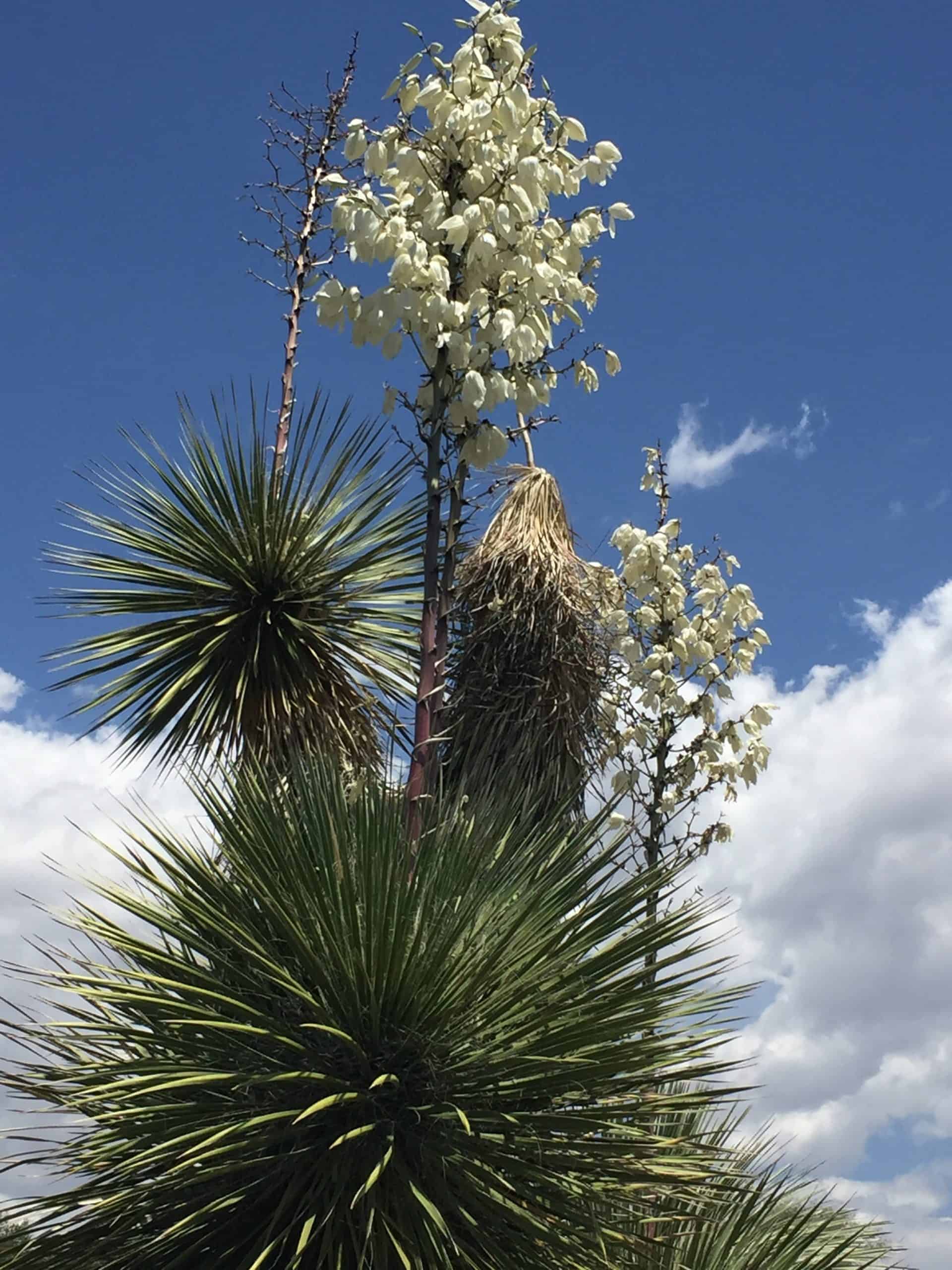Last Updated on August 17, 2024 by Alice Benny
The yucca plant is a popular ornamental indoor and outdoor shrub. Although it’s easy to confuse the names yucca and yuca, these are two different plant species.
We’ll be covering the yucca plant here, which doesn’t have an edible starchy root but has excellent medicinal properties and other uses.
Yucca plants are perennial evergreen trees and shrubs. Most are in the family Asparagaceae. Some varieties flower and a few produce edible fruit. They are not cactus.
Yuccas are often used as accent plants and ornamental landscaping in arid and semi-arid climates. Yuccas are low maintenance. They are ideal desert plants because they are drought-tolerant. Depending on the variety, some can provide desert survival food.
Spineless yucca grow well as houseplants.
Yucca Plant
There are over 45 species of yucca plants. Some yuccas grow to look like palm trees because the yucca leaves grow on thick cane stems. Others grow like shrubs with tall flowers shooting out.
Common varieties resemble a giant pineapple top.
Its tough, sword-shaped leaves can make the plant stand from two to thirty feet tall and up to 25 feet wide.
Yucca leaves are long, pointy and sometimes very sharp. They can resemble palm fronds. Grow spineless yucca when growing indoors.
Depending on the yucca species, the plant may flower one or more times per year. Some varieties produce loose or dense rosettes with bell-shaped flowers. Yucca flowers are cream or white. The flowers grow tall out of the center of the plant.
An insect called a yucca moth is this plant’s primary pollinator.
The yucca plant is native to hot and dry regions of the Americas and Caribbean. However, nowadays, you can find yucca growing in prairies, woods, and subtropical climates.
Yuccas thrive outdoors in climate hardiness zones 7 – 9 but can grow in zones 5 – 10. Some species can grow in 3 – 11 as well.
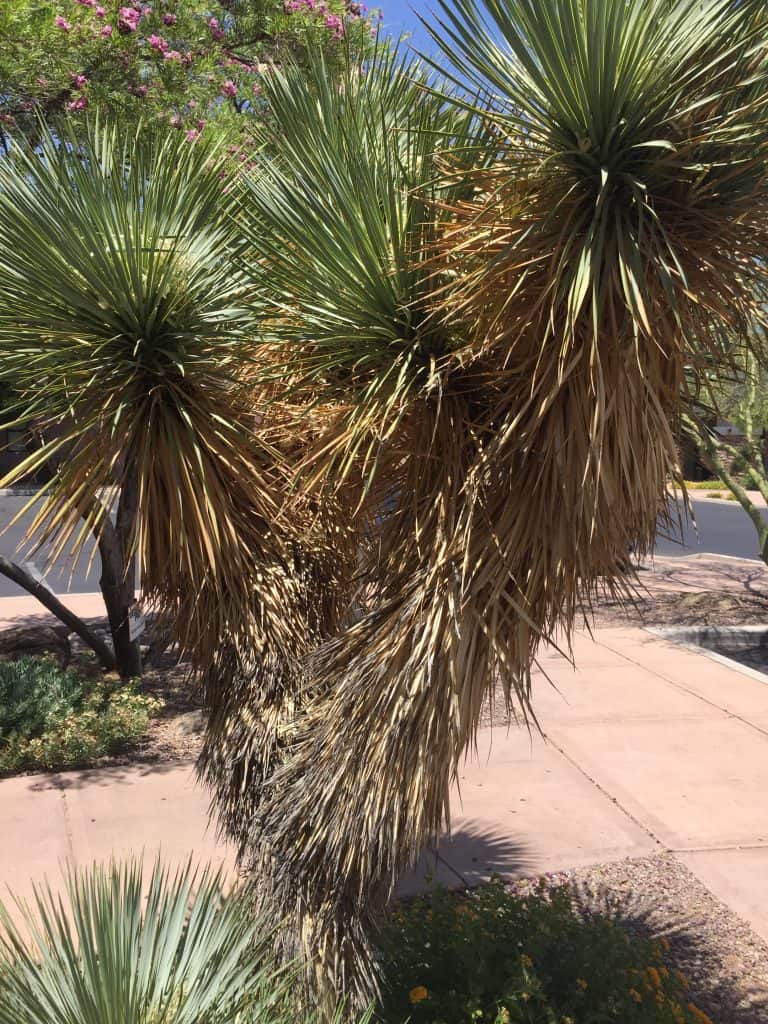
Yucca Uses
There are uses for yucca but remember it’s different from a yuca plant. One question people often ask about the yucca is: What can you use from it?
- Ornamental landscaping
- Accent plants
These are popular plants to use as ornamental landscaping to beautify spaces at home and commercially. You’ll often see them in front of buildings as entryways, subdivisions, and in street medians.
- As hedges
- Property boundary markers in place of fences
At home, they can provide functional landscaping. They can create borders and areas on your property. Yucca leaves are sharp and can work as deterrents for intruders as well as animals.
- Houseplant
- Container plant for patio
It’s also an easy-to-care-for houseplant. They grow well in pots in most all areas and do well outdoors in a wide range of climates. Choose the spineless variety when growing in a pot.
- To eat
Some types of yucca offers edible parts. The exact parts you can eat depends on the yucca species. Edible yucca parts can include:
- Fruits: Small, oval-shaped
- Leaf bases
- Flower stalks: Remove before they bloom so they aren’t fibrous and without flavor. You can cook them or eat raw while they’re tender. (They’ll look like asparagus.)
- Flowers: If you eat the flowers, don’t eat the stalks
- Stems: Toxic, must boil to break down
- Emerging, tender stalks
Yucca Fruit
To grow a yucca plant as a food source or as desert survival food, grow a species that fruits. It’s the easiest part you can use from a yucca plant where you’ll get the most return.
Edible yucca fruit grow on varieties that have thick leaves. You can pick yucca fruits when they are ripe or unripe, depending on the type.
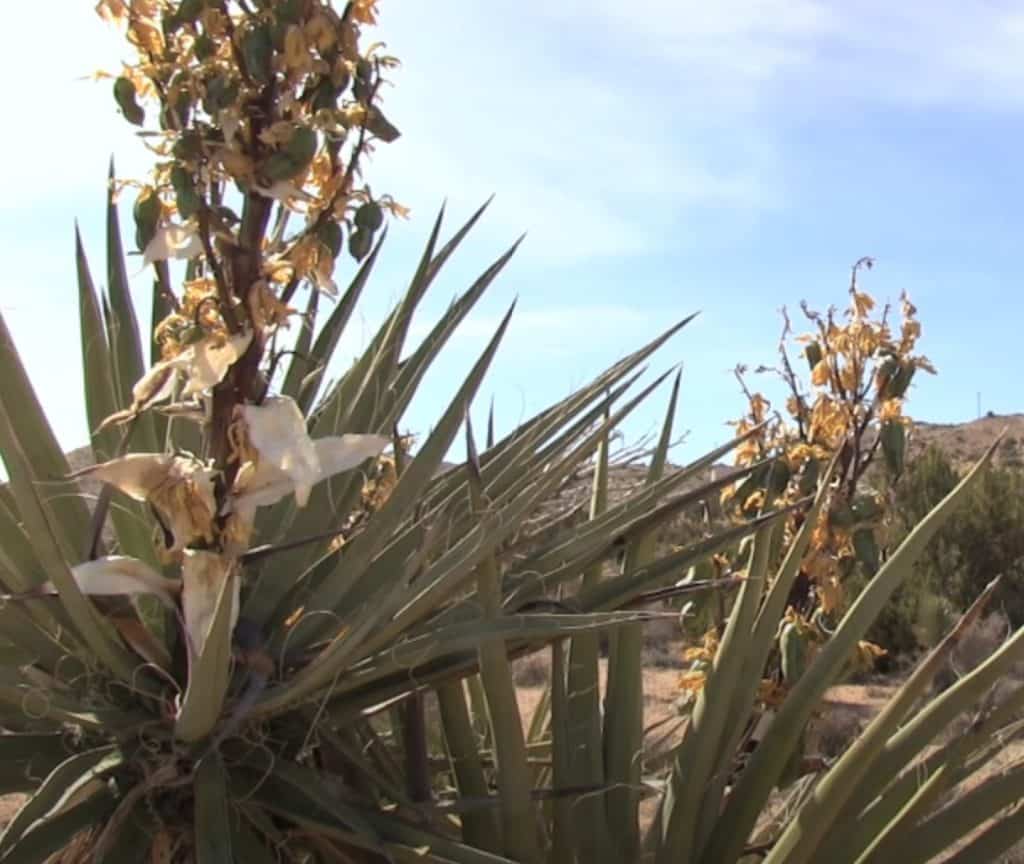
Mojave Yucca
You can eat fruits and other parts from this species, Yucca schidigera. It is hardy to zones 9 – 10.
- Flower: Raw or cooked; dried, crushed for flavor; add to jellies
- Fruit: Raw or cooked; jelly; bake and dry then ground into power for soup, stew, drinks
- Young flowering stems: Cut, cooked like asparagus; baked like a sweet potato
With the Mojave, it’s best to harvest yucca fruits when they’re immature. They should be the size of a small pickle. During this stage, the fruits have less saponin which can be toxic.
Don’t wait until the fruits grow large because of the saponin. You can use saponin in soapmaking. Also, don’t eat if seeds inside are black.
The fruits are green, 3 – 4 inches long, and slightly pear-shaped. You can harvest them without needing gardening gloves.
You’ll want to bake or roast them rather than eat them raw. In addition, use them as a puree or in smoothies. Dried yucca fruit will last for several months. Dry and grind them to use as you would meal. Note, this is different than yuca root from the cassava plant.
Banana Yucca
This species, Yucca baccata, is another fruiting variety. It’s also called Spanish Bayonet, Blue Yucca, Spanish Yucca. It’s hardy to climate zones 6 – 11.
From this plant, you can eat: Flowers, fruit, leaves, seed, stem.
It produces slightly sweet fruits. When fully ripe, you can enjoy it raw, cooked or dried.
In addition to the banana-shaped fruits, you can eat the flowers, leaves, seeds, and stem. The plant itself has blue-ish green foliage.
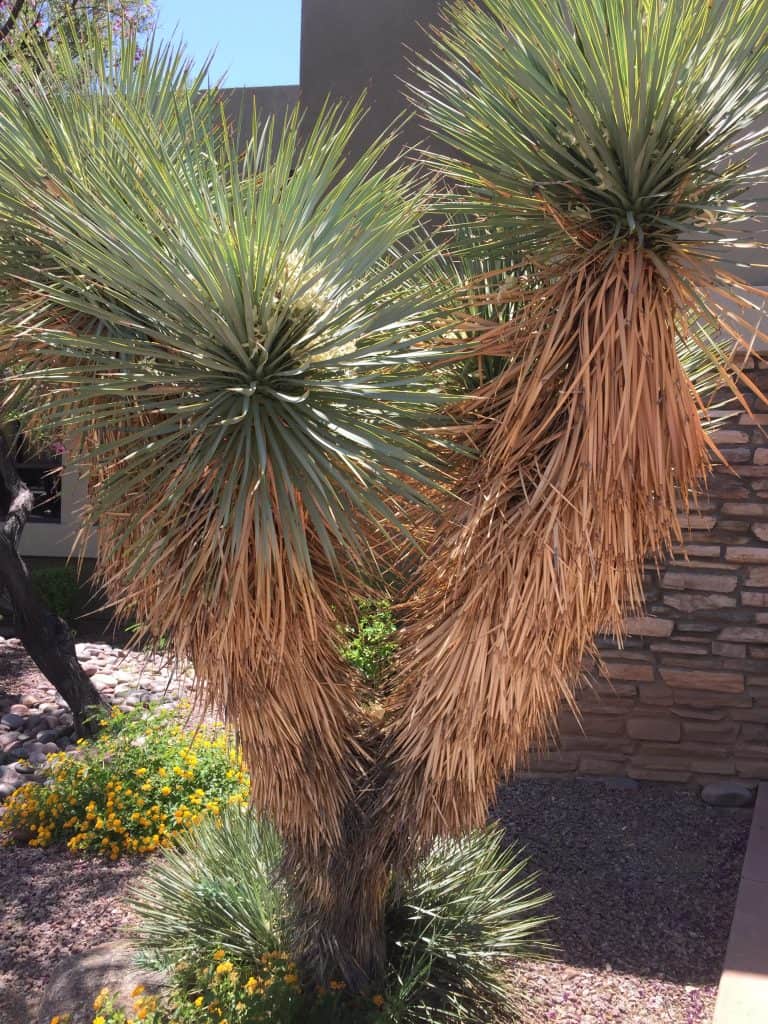
Benefits
They are ideal plants to grow in areas with poor soil. There are other yucca benefits as well, including:
- Leaves: for weaving, kindle wood
- Central stalk, trunk: soap
- Roots: soap, medicinal (Note this is different than yuca root from the cassava plant)
- Sap: skin aliments
You may hear people refer to the yucca plant as a soaptree. It gets this name because Native Americans use its roots to make soap and shampoo. You can buy yucca powder to make them at home.
The yucca plant also has strong leaf and trunk fibers that historically made it a valuable plant for household needs.
For example, when dry, the yucca leaves make excellent kindle wood. People also use the fibers to hang up meat for salt curing.
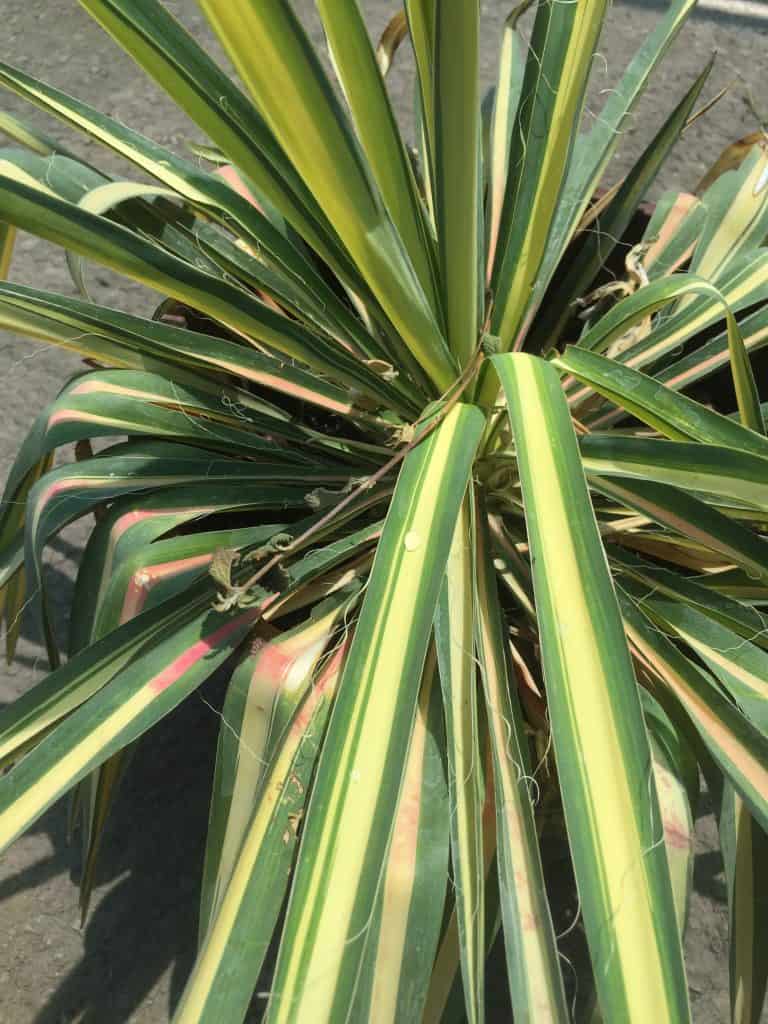
How to Plant Yucca
Now that you have some background on this plant, let’s talk about how to grow yucca. We’ll cover the requirements for growing it indoors and outdoors.
You can grow yucca from seed or go to a nursery, garden center or a home improvement stores to buy a plant.
They are also easy to propagate from existing plants.
Indoors as a Houseplant
When choosing a variety to grow indoors, consider a spineless type which is also called stick yucca or a yucca cane plant.
Spineless varieties don’t have sharp leaves or spines, making them safe for pets and children. One to choose is Yucca elephantipes.
The great thing about planting yucca indoors is that you can plant it at any time of year.
When planting yucca seeds in a pot of soil, you should soak the seeds in water for 24 hours in advance of planting. This will speed germination.
You should plant seeds between one to two times the depth of the seed’s length. After about three to four weeks, the seeds will begin to germinate. They’ll germinate well in temperatures that range from 60 – 70 degrees F.
Yucca seedlings need more water than adult plants, so you should aim to keep the soil moderately moist in well-draining containers.
After eight weeks, your seedlings will be ready for transplanting into a larger pot. Any type of pot will do provided that it’s sturdy and has holes in the bottom. Good drainage is essential for a healthy potted yucca plants.
Place it in an area by a window so it receives bright, unfiltered light. Typically, this will be by a south-facing window. Turn them regularly; these plants will grow toward the light. You’ll want to be sure they grow evenly and aren’t lopsided.
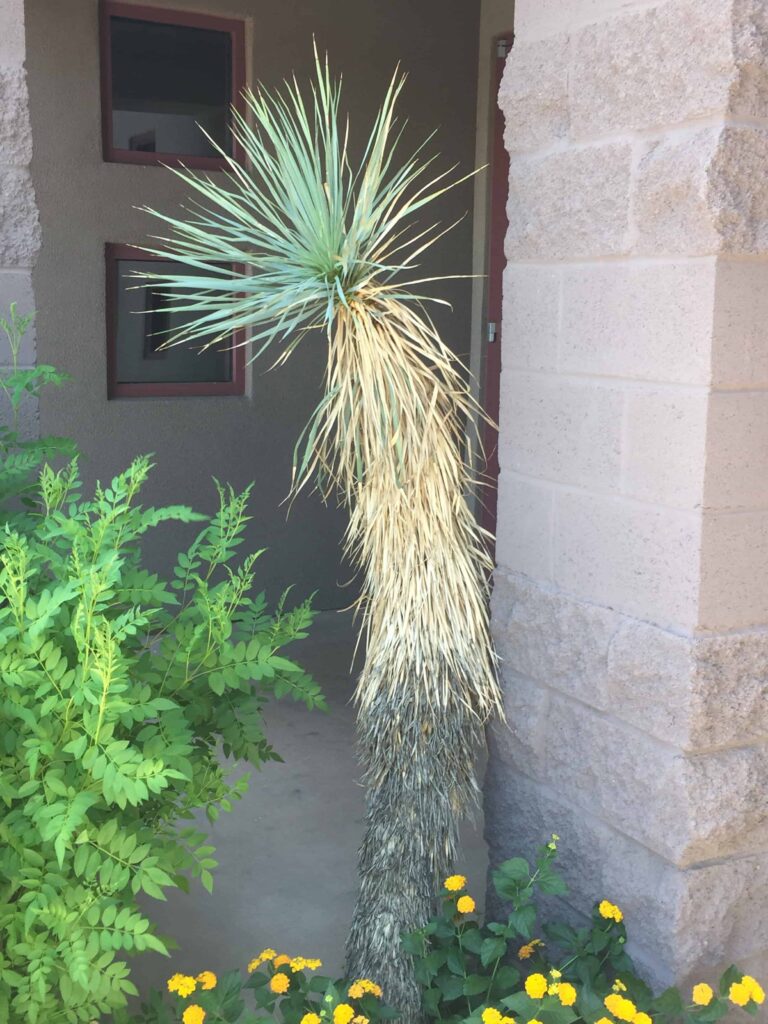
Outdoor Yuccas
Planting yucca outdoors takes a little more preparation than planting them indoors. You should aim to plant in the spring once the temperatures are between 55 to 65°F.
That said, certain yucca plant varieties aren’t as hardy, so you should double-check the seed package or plant type to verify temperature recommendations.
When choosing a place to plant this desert plant outdoors, you’ll want to ensure that it’ll have access to full sun and a well-draining area. Some people prefer to keep their outdoor yucca plants potted, as yucca plants can crack foundations as they grow.
However, they are ornamental plants and used for landscaping and to create borders and will do well in the native soil, especially in the southwest.
Go to a nursery and see the different types. Start from established plants rather than from seed when using for landscaping.
Regardless of whether you plant your yucca inside or outside, keep in mind that this is a slow-growing plant. Therefore, it could take a few years before they begin to flower.
Caring for Yucca Plant
These plants are ideal for beginner gardeners and people who don’t have green thumbs. This is because they require little water. The requirements for growing are simple. After all, it has a strong hardiness.
Watering
During the spring and summer, you can aim to water your plant once per week with about one inch of water. In the winter, you can reduce the number of times you water it, although an occasional deep watering is helpful to mimic nature.
Once established, they won’t need watering if they grow in the ground. Monsoons and rainfall should be enough. They are frost tolerant.
Signs to watch for:
- Brown lower leaves: Can mean underwatering; however, it’s natural for them to shed as it grows
- Crisp lower leaves: Can be ready to shed or can need more water
- Drooping, sagging leaves: Can mean not enough light or underwatering or overwatering
- Yellow, limp lower leaves: Overwatering
If the plant shows signs of overwatering, let the soil dry out completely.
If you suspect root rot, remove the plant and gently remove the rotting roots. Repot in a different pot or wash out the existing pot. Keep the root ball and use new soil. Do not water and then resume watering sparingly.
Be sure the pot has drainage holes and that the plant doesn’t rest in excess water.

Pruning Yucca Plant
Pruning is essential if you keep it potted indoors. With a potted yucca plant, you’ll need to prune it so that you don’t have a massive shrub growing in your home.
If you are growing them outdoors in pots, you can prune as well so they don’t overtake the pot. Aim to prune in the early spring, before its growing season.
Be sure to wear gloves as many species have sharp leaves.
Pruning yuccas outdoors is optional when they grow in the ground. Some types will attract packrats who will nest underneath so you’ll want to check the base of yucca shrubs. You can remove any dead or dying leaves from around the base of the yucca plant.
If you don’t have a packrat problem, you can let its fallen leaves remain scattered around the base of its trunk. The reason being is that the leaves help protect the plant from the sun and encourage dew and rain to channel down to its roots.
Pruning is easy. Simply cut the trunk top down to the height you desire. Before long, new growth should replace the sparse-looking top. You can propagate the top to grow a new plant.
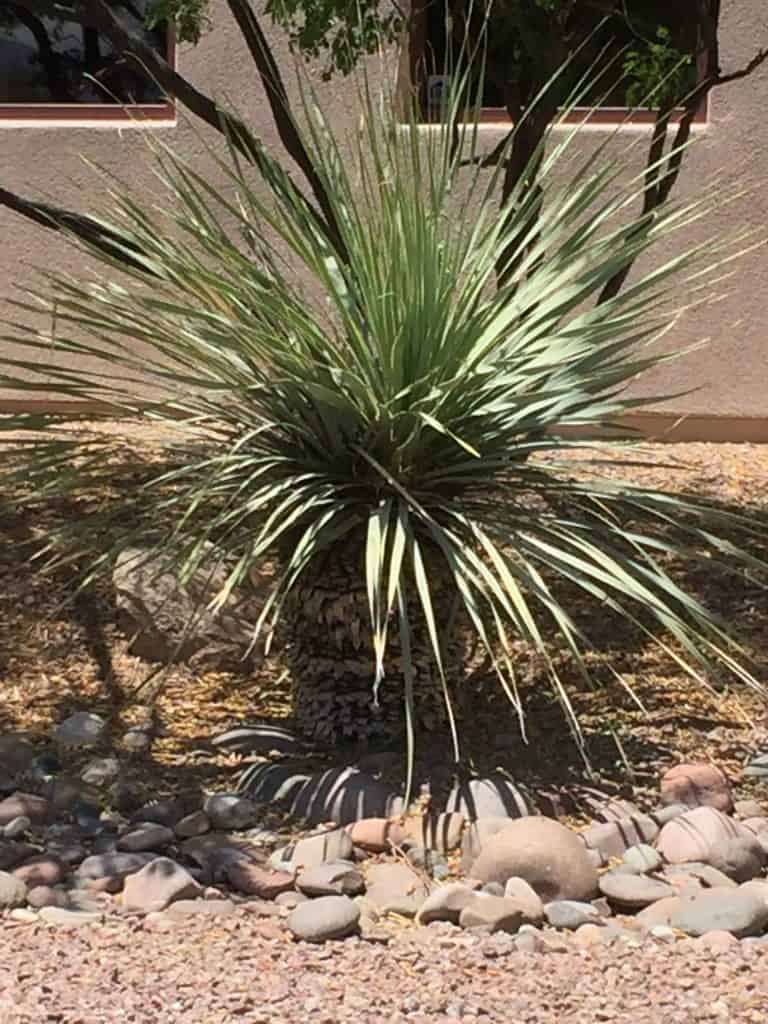
Tips for Growing Yucca
Wondering where and when to plant yucca? Well, one of the reasons it’s so popular is that cultivating it is easy with any soil type.
The important part to consider is that the soil allows for easy drainage so the roots don’t rot. If you notice the leaves turning yellow or becoming soft, this is a classic sign that the drainage is poor or you’re overwatering your plant.
It’s an excellent plant for propagating from offsets. If you wish to propagate, remove the offsets in the spring and cut off any foliage. Plant them in a separate pot using the strategies we covered here, and within three to four weeks, the roots should take hold.
Varieties
With close to 50 varieties of yucca plants, there are many to choose from depending if you want to grow them indoors or outdoors, in pots and containers or in the ground.
Also consider if you want them as ornamental landscaping and/or to form a natural barrier or property marker. Some produce flowers. Some grow tall while others remain closer to the ground.
Lastly, consider if you want to have edible fruits from the plant.
Red Yucca Plant
Texas red yucca, Hesperaloe parviflora, is an evergreen perennial. It produces red flowers. It blooms for over 28 days. It will attract bees, butterflies, and hummingbirds. It’s spread is up to three feet.
Ready to Plant?
With few diseases that affect the yucca plant and low-maintenance qualities, this is an ideal plant for busy people who want to spruce up their home or yard with attractive and low maintenance landscaping.
It is slow-growing but will remain hardy and grow for years.
Remember, this is different than yuca which is a root with many benefits. There are big differences when considering yucca vs yuca.
Yuccas produce beautiful flowers. See 10 Ways to Make Your Garden Look Beautiful
Alternative Landscaping Ideas For Your Rural Property
Quinoa Plant is another plant with food that contains saponin.

